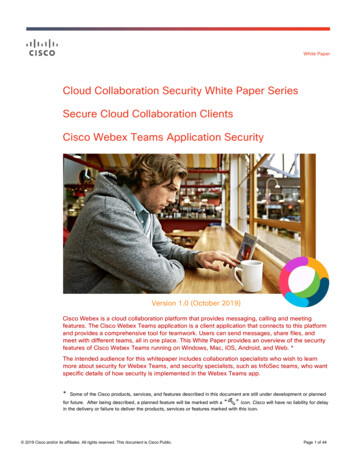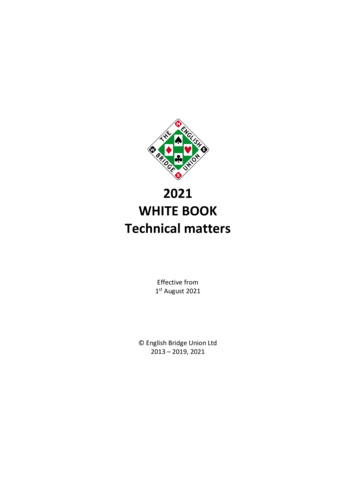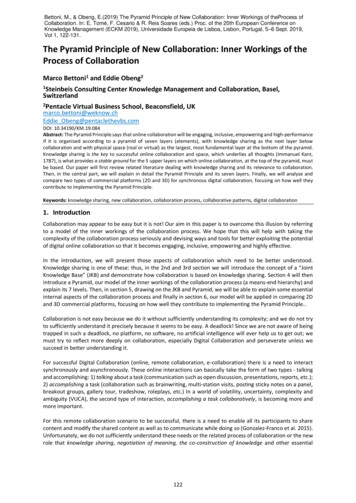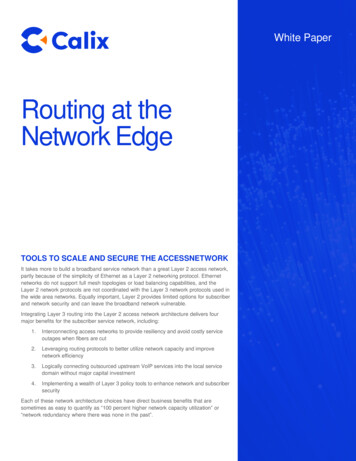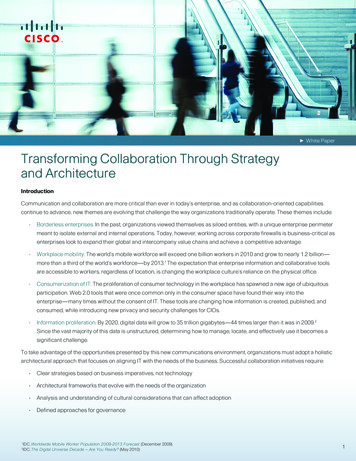
Transcription
White PaperWhite PaperTransforming Collaboration Through Strategyand ArchitectureIntroductionCommunication and collaboration are more critical than ever in today’s enterprise, and as collaboration-oriented capabilitiescontinue to advance, new themes are evolving that challenge the way organizations traditionally operate. These themes include: Borderless enterprises: In the past, organizations viewed themselves as siloed entities, with a unique enterprise perimetermeant to isolate external and internal operations. Today, however, working across corporate firewalls is business-critical asenterprises look to expand their global and intercompany value chains and achieve a competitive advantage. Workplace mobility: The world’s mobile workforce will exceed one billion workers in 2010 and grow to nearly 1.2 billion—more than a third of the world’s workforce—by 2013.1 The expectation that enterprise information and collaborative toolsare accessible to workers, regardless of location, is changing the workplace culture’s reliance on the physical office. Consumerization of IT: The proliferation of consumer technology in the workplace has spawned a new age of ubiquitousparticipation. Web 2.0 tools that were once common only in the consumer space have found their way into theenterprise—many times without the consent of IT. These tools are changing how information is created, published, andconsumed, while introducing new privacy and security challenges for CIOs. Information proliferation: By 2020, digital data will grow to 35 trillion gigabytes—44 times larger than it was in 2009.2Since the vast majority of this data is unstructured, determining how to manage, locate, and effectively use it becomes asignificant challenge.To take advantage of the opportunities presented by this new communications environment, organizations must adopt a holisticarchitectural approach that focuses on aligning IT with the needs of the business. Successful collaboration initiatives require: Clear strategies based on business imperatives, not technology Architectural frameworks that evolve with the needs of the organization Analysis and understanding of cultural considerations that can affect adoption Defined approaches for governanceIDC, Worldwide Mobile Worker Population 2009-2013 Forecast (December 2009)IDC, The Digital Universe Decade – Are You Ready? (May 2010)121
White PaperFor CXOs, this is a call to rethink business models, processes, and cultures.Specifically, for CIOs, this represents a unique opportunity to transform the role of IT inthe enterprise. By developing a business-led strategy and accompanying architecturewith stakeholders across corporate communications, human resources, finance,sales, and other departments, IT can evolve from a service-oriented cost center to astrategic partner that delivers long-term business value to the organization.Considerations for CollaborationCollaboration is unique in its potential to affect every employee, business partner,and customer. Although recent advances in collaborative technologies havebrought an increased awareness and focus to the discipline, collaboration existedlong before personal computers, smart phones, and video solutions entered theworkplace. Today’s environment, however, provides an extraordinary opportunity toreevaluate and transform the ways in which enterprises collaborate. Collaboration is much more than just technology. Collaboration is morethan a technical architecture, solution, or product, it is the transformationalexperience that integrates people, processes, and technology. Collaboration isthe catalyst for evolving from merely using technology to rethinking business,changing process, and adapting culture. As a result, holistic collaborationstrategy and architecture must account for—and address—not only thetechnology, but also the effect those solutions will have on an organization’sprocesses and culture. Successful collaboration is not a “one size fits all” proposition. Strategies andarchitectural solutions must be flexible enough to account for the uniquecommunication and collaboration needs of both internal (executives, sales,knowledge workers, and so on) and external (customers, suppliers, vendors,and so on) stakeholders. For example, a highly mobile sales force will likelyhave a different collaboration profile than traditional, office-bound workers.Organizations should consider the complexities within their given industry.For instance, collaborative solutions that are effective within media andentertainment enterprises might have minimal applicability within the regulatedworld of financial services. However, best practices that have been establishedwithin one industry can be adapted and applied to another. User adoption is the primary indicator of collaboration success. Successfulcollaboration relies on the “network effect,” which states that a product orservice’s value increases as more people use it. Before a collaboration toolcan deliver value, it must have active participants. However, without a clearalignment to business imperatives and objectives, collaborative technologiesrisk becoming isolated silos of functionality. Moreover, if only individualemployees or departments adopt the deployed capabilities, anticipatedbenefits fall short of business expectations, and operational complexity andoverhead increase for IT organizations.2
White PaperHolistic Collaboration ArchitecturesOften the terms unified communications, Web 2.0/Enterprise 2.0, and social media are used interchangeably to describecollaboration. However, none of these terms is synonymous with collaboration, because each represents only a subset of themuch broader spectrum (see Figure 1). For enterprises to develop and embrace a comprehensive vision, they must make surethe evaluation process extends beyond unified communications or Web 2.0 and consider all collaborative capabilities.Enterprise collaboration strategy and architecture, however, should not necessarily result in a roadmap for deploying everyavailable collaborative capability. The evaluation process should lead to a collaboration strategy and architecture that areselective, consisting only of those capabilities that help meet identified business imperatives.Figure 1 illustrates a vendor- and product-independent conceptual collaboration architecture. It is designed from theperspective of the enterprise and provides a structured framework for evaluating collaboration needs. The diagram alsoidentifies a comprehensive list of collaboration capabilities and defines a holistic view of the architectural components anenterprise must consider when evaluating collaboration initiatives.Figure 1. Conceptual Collaboration ArchitectureEnterprise UsersKnowledgeWorkersExternal rowserPresentation / Device LayerSuppliers/VendorsPartnersPlugin.Smart ClientPersonalization / CustomizationBusiness ProcessCOLLABORATION ENABLED APPLICATIONSCOLLABORATION INTEGRATED APPLICATIONSCOLLABORATION RPRISESERVICESCollaborationPlatformsCORE COLLABORATION entManagementSocial Bookmarking ng /SchedulingBloggingBroadcastPoint-to-PointSpeech to TextText to SpeechInteractiveInteractive VoiceResponseActivity HistoryAnnouncement /Bulletin BoardsResource Mgmt.Content eboardReal Time ualization ManagementTransport ManagementVoiceIndexingContent ementHumanResourceManagementBroadcastAudio / Video ConferencingWeb ConferencingLifestreaming /MicrobloggingRatings /VotingVideoPoint-to-PointPublishing xShared erWorkflows e /MeteringIP.Network ServicesNetwork(on-prem / off-prem)3
White PaperThe components depicted in Figure 1 are defined as follows: Network/network services: The network platform enables collaboration functionality to be extended and managed acrossand outside the enterprise. Core collaboration capabilities: These are the foundational building blocks for all collaboration solutions. Capabilities areupdated as needed when new core technologies emerge. Collaboration suites: These aggregated sets of two or more core collaboration capabilities are dedicated strictly tocollaborating; instant messenger applications, for example, provide some combination of the following core collaborationcapabilities::-- Instant messaging-- Availability presence (away, busy, do not disturb)-- Device presence (on hook/off hook)-- Point-to-point video-- Point-to-point voice Enterprise services: These business-critical systems and data are used to implement and manage the business but donot necessarily facilitate collaboration. Examples include enterprise resource planning, human resource management,and so on. Collaboration-integrated applications: These tools encompass a mix of core collaboration capabilities, collaboration suites,and enterprise services into an entirely new application. An example is a collaborative mashup that combines availabilityand device presence with enterprise directory information and enterprise search to create an expertise location application. Collaboration-enabled applications: These tools use core collaboration capabilities and suites to extend the functionality ofa base application with collaboration features.3 An example is providing availability presence within a customer relationshipmanagement application. Business processes: Both formal and impromptu business processes promote collaborative interactions. To providerelevance, a collaboration architecture must recognize and support the needs of all business processes. Personalization/customization: These characteristics allow the architecture to dictate collaborative capabilities based onuser role, while giving users the ability to customize their collaboration experience based on individual preferences. Presentation/device layer: This architectural layer offers various interfaces for customizing collaboration processesand data that recognize, for example, the different collaboration experiences on a mobile device versus a desktopcomputer, optimizing around these differences. User profiles (enterprise/external): These profiles address individual users’ unique communication and collaborationneeds to help ensure the business and technical relevance of the architecture. Governance: The structured use of people and processes supports effective, long-term management and growth ofcollaborative solutions.Also referred to as contextual collaboration34
White PaperThe end result of any collaborative architectural analysis should identify initiatives that fall into one or more of the followingcategories: Deployment/modification of core collaboration capabilities Deployment/modification of collaboration suites Deployment/modification of collaboration-enabled applications Deployment/modification of collaboration-integrated applicationsEnable vs. IntegrateCollaboration-enabled applications provide collaborative capabilities within the context of an existing business application (seeFigure 2). End users view these capabilities as an enhancement, rather than a replacement, of the original application. Althoughsome training might be needed to take full advantage of the added collaborative features, users will not require wholesaletraining because they still understand the original business application.Conversely, collaboration-integrated applications introduce completely new applications by creating mashups. End users donot have the benefit of understanding the application’s prior purpose and use, making user adoption—and achieving positivebusiness effect—more challenging. They often need formal training and communications to learn why, how, and when to use theapplication. New solutions generally warrant separate application and operations support procedures as well, requiring more timeand resources to achieve the desired results.Figure 2. Approach for Developing Collaboration borationSuitesCore ration EnabledApplications5
White PaperVendor-Specific ArchitecturesIn contrast to the conceptual collaboration architecture shown in Figure 1, vendor-specific architectures, like the Cisco exampledepicted in Figure 3, are used to communicate (and differentiate) a product portfolio’s capabilities and overall value proposition.Figure 3. Cisco Collaboration Architecture6
White PaperCisco’s collaboration architecture4 emphasizes interoperabilty and openness,allowing any device or application to use core collaboration services enabledthrough a set of flexible deployment models—on premises, software as a service(SaaS), or a hybrid of both.Models such as these help enterprises understand a vendor’s architecturalapproach, establishing, for example, whether the approach is network-centric,application-centric, or a combination of the two. However, in order to determinethe relevancy and applicability of a given vendor’s collaboration architecture,enterprises should first identify what capabilities are required within the context of acollaboration strategy.Essential Architectural Evaluation CriteriaAssessing collaboration within the context of architectural capability is critical tomaximizing the long-term viability and strategic relevance of any collaborativeinfrastructure decision. As considerations such as extensibility, scalability, andintegration flexibility become more integral to delivering strategic objectives,enterprises should look beyond product demonstrations and advertised feature lists.Organizations should ask themselves questions such as: Will requirements dictate that collaborative capabilities be exposed orembedded within other applications and/or services? As the enterprise grows, must the desired collaborative capabilities scale tomeet the projected need? What types of collaboration does the enterprise require (for example, processcentric, activity-centric, community-centric, network-centric, and so on)?Making vendor selections without understanding the architectural implicationsposed by such questions can severely limit a collaboration architecture’s ability toaddress present and future business needs.Developing a Collaboration StrategyA collaboration strategy promotes the alignment of applications, services, devices,and content into a cohesive, unified architecture that optimizes business andorganizational processes and facilitates innovation. Enterprise organizations shouldorient the strategy toward a business-centric focus, allowing business requirements,not technology, to define collaboration initiatives.For more detail about the Cisco Collaboration Architecture, visit www.cisco.com/en/US/solutions/ns340/ns858/collab framework.html47
White PaperBusiness factors such as borderless enterprises, workplace mobility, consumerization of IT, and the rapid proliferation ofinformation are placing transformational pressures on organizations. Success depends on the alignment of business and ITobjectives through a comprehensive, strategic approach. Without an overarching strategy, the approach becomes fragmented,leading to: Excess costs High failure rate for technology solutions Challenges with interoperability between systems and across business units The inability to rapidly adapt to changing collaborative needs Overlaps in tools and processes Security and regulatory compliance issuesA comprehensive approach to developing a collaboration strategy should consist of three core phases (Figure 4).Figure 4. Approach for Developing Collaboration StrategiesIn the business alignment phase, stakeholders across IT and the business focus on identifying the primary collaborationrequirements based on business need. They can then establish a strategic collaboration vision, which serves as the referencefor further collaborative technology analysis.8
White PaperDuring the process and organizational analysis phase, thought leaders analyze the enterprise's existing collaborationenvironment to determine the extent of collaborative technology and functionality present (also called collaboration mapping).In this phase of strategic development, it is critical for stakeholders to understand which existing investments they mustincorporate into the desired end state and determine where they can consolidate redundant capabilities (such as multiple wikiplatforms). An assessment of user roles, cultural analysis, and existing governance helps determine gaps that might prevent theorganization from achieving desired end state capabilities.During the target business initiatives phase, thought leaders develop and refine value propositions based on the analysis ofsupporting collaborative business cases. This process leads to a prioritized, strategic, architectural roadmap that supportsidentified business initiatives.Table 1 illustrates common activities associated with developing collaboration strategies.Table 1. Common Collaboration Strategy ActivitiesPhaseBusiness alignmentActivities Conduct the collaboration discovery session with business and IT stakeholders Identify and prioritize collaborative areas of focus Capture business imperatives across in-scope organizationsProcess and organizational analysis Inventory existing collaboration technologies and business processes Assess organization’s collaboration capability (internal and external), current state, anddesired future stateTarget business initiatives Identify effect zones Define strategic collaborative opportunities Define tactical collaborative opportunities Design to-be collaboration process/technology architecture Create high-level to-be collaboration use cases Estimate business effect and cost9
White PaperConclusionGartner, a leading IT research and advisory company, forecasts that through 2012, more than 70 percent of IT-influenced socialmedia collaboration initiatives will fail.5 Business requirements, not technology, shape successful collaboration initiatives. Ascollaboration becomes increasingly strategic to overall enterprise success, IT organizations must transition from deployingtechnology to deploying business-relevant technology solutions.This shift requires that stakeholders from across the organization align to develop a cohesive collaboration vision thatemphasizes capabilities, not products.Cisco Collaboration Services employs a business-centric, product-independent approach to define collaboration strategiesand architectures for companies that are relevant in terms of technology and business goals. Cisco’s holistic perspectiveon collaboration, combined with a deep understanding of the underlying technologies, allows organizations to maximize thebenefits of collaboration on the network platform.For more information about Cisco’s Collaboration Services and how we help our customers develop collaboration strategies andarchitectures, click here.Gartner, Predicts 2010: Social Software Is an Enterprise Reality (December 2009)5Americas HeadquartersCisco Systems, Inc.San Jose, CAAsia Pacific HeadquartersCisco Systems (USA) Pte. Ltd.SingaporeEurope HeadquartersCisco Systems International BVAmsterdam, The NetherlandsCisco has more than 200 offices worldwide. Addresses, phone numbers, and fax numbers are listed on the Cisco Website at www.cisco.com/go/offices.2010 Cisco and the Cisco Logo are trademarks of Cisco Systems, Inc. and/or its affiliates in the U.S. and other countries. A listing of Cisco's trademarks can be found at www.cisco.com/go/trademarks. Third partytrademarks mentioned are the property of their respective owners. The use of the word partner does not imply a partnership relationship between Cisco and any other company. (1005R) 10
Enterprise collaboration strategy and architecture, however, should not necessarily result in a roadmap for deploying every available collaborative capability. The evaluation process should lead to a collaboration strategy and architecture that are selective, consisting only of those capabilities that help meet identified business imperatives.

